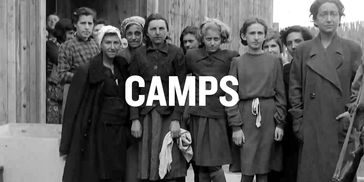Holocaust Explainer Videos

Camps
Nuremberg Trials
Kristallnacht
From Adolf Hitler’s rise to power in 1933 until the end of World War II in 1945, the Nazis imprisoned millions of people in tens of thousands of sites throughout Germany and German-occupied Europe. Many of these sites were called camps. The Nazis established many types of camps, including concentration camps, forced-labor camps, transit c
From Adolf Hitler’s rise to power in 1933 until the end of World War II in 1945, the Nazis imprisoned millions of people in tens of thousands of sites throughout Germany and German-occupied Europe. Many of these sites were called camps. The Nazis established many types of camps, including concentration camps, forced-labor camps, transit camps, and five killing centers, among others. By the end of the Holocaust and World War II, millions of people died from exhaustion, starvation, and deliberate mass murder in the camps.

Kristallnacht
Nuremberg Trials
Kristallnacht
On November 9th and 10th, 1938, Nazi German leaders organized a series of violent, nationwide attacks against Jewish communities. This event, later called the "Night of Broken Glass," or Kristallnacht, marked a terrifying escalation in violence against Jews. This video explores what happened during Kristallnacht, how some ordinary Germans
On November 9th and 10th, 1938, Nazi German leaders organized a series of violent, nationwide attacks against Jewish communities. This event, later called the "Night of Broken Glass," or Kristallnacht, marked a terrifying escalation in violence against Jews. This video explores what happened during Kristallnacht, how some ordinary Germans participated in the riots, and the lasting impact of the violence and destruction. After the attacks, many Jews decided they had no choice but to flee Nazi Germany for their own safety.

Nuremberg Trials
Nuremberg Trials
Nuremberg Trials
After World War II, several nations collaborated to hold the Nuremberg Trials, aiming to bring Nazi leaders to justice for war crimes, crimes against peace, and crimes against humanity. The main trial, called the International Military Tribunal (IMT), focused on the most prominent war criminals. This video details the historic event, the
After World War II, several nations collaborated to hold the Nuremberg Trials, aiming to bring Nazi leaders to justice for war crimes, crimes against peace, and crimes against humanity. The main trial, called the International Military Tribunal (IMT), focused on the most prominent war criminals. This video details the historic event, the accused, and the convictions, highlighting how the evidence presented, including documents, photos, and testimony, is crucial to our understanding of the Holocaust.

Ghettos
Nuremberg Race Laws
Nuremberg Trials
The Nazis and their allies set up ghettos to isolate and control millions of Jews during the Holocaust. Life in the ghettos was overcrowded and miserable, with limited access to food, clean water, heat, and medical services. Despite the conditions, Jews found ways to maintain dignity and community. This video explores how many ghettos wer
The Nazis and their allies set up ghettos to isolate and control millions of Jews during the Holocaust. Life in the ghettos was overcrowded and miserable, with limited access to food, clean water, heat, and medical services. Despite the conditions, Jews found ways to maintain dignity and community. This video explores how many ghettos were established and when, life in the ghettos, and how Jews resisted Nazi control, both secretly and through violent acts like the Warsaw Ghetto Uprising.

Nuremberg Race Laws
Nuremberg Race Laws
Nuremberg Race Laws
In 1935, the Nazi regime took a significant step toward isolating and excluding Jews and other groups from German society through the passage of two laws. These Nazi laws stripped Jews of their German citizenship and made relationships or marriages with non-Jews illegal. Later on, the laws were changed to include the Nazis' definition of
In 1935, the Nazi regime took a significant step toward isolating and excluding Jews and other groups from German society through the passage of two laws. These Nazi laws stripped Jews of their German citizenship and made relationships or marriages with non-Jews illegal. Later on, the laws were changed to include the Nazis' definition of who was considered Jewish. This paved the way for more discrimination and ultimately played a role in contributing to the Holocaust. This video explains the impact of these laws.

Nazi Propoganda
Nuremberg Race Laws
Nuremberg Race Laws
This video explains what propaganda is and how Hitler and the Nazis used it to exclude Jews and other groups from German society. They relied on a variety of advertising techniques, like catchy slogans and symbols, and used the most current technology of the time to spread their messages. Through censorship and control of various media li
This video explains what propaganda is and how Hitler and the Nazis used it to exclude Jews and other groups from German society. They relied on a variety of advertising techniques, like catchy slogans and symbols, and used the most current technology of the time to spread their messages. Through censorship and control of various media like radio, film, newspapers, and theater, the Nazis were able to demonize Jews and turn German society against them.
